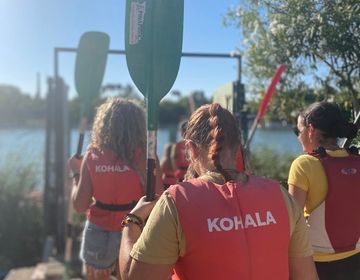Ceramic Tiles Class
Yesterday, we had an incredible experience in the Triana neighborhood in Seville, specifically at the Barrio Azul ceramics workshop. This area is known for its rich tradition in Spanish ceramics, and our students had the opportunity to immerse themselves in this fascinating craft.
We began with an introduction to the history of tiles and their importance in Sevillian culture. Did you know that the use of ceramic tiles in Seville dates back to the Islamic period? It goes even back to 12th century, when the city was under Muslim rule. The art of ceramic tile making was brought by the Moors, and it has since become an integral part of Seville's architectural and cultural heritage.
Ceramic tiles, or azulejos, are deeply embedded in Andalusian culture. They adorn many historic buildings, churches, palaces, and homes throughout Seville. These tiles often feature intricate designs and patterns that reflect the city’s rich history and the blending of various cultural influences, including Islamic, Gothic, Renaissance, and Baroque styles. They are truly beautiful and it makes you want to have them in your home.
Our hosts, Priscilla Ruiz, a ceramist specialized in cuerda seca technique, offered us a detailed explanation of the techniques and processes used in creating ceramics. She taught us the main techniques of Sevillian ceramics, such as ropa seca, edge, smooth cover and sgraffito. Each technique has its own history and method, and it was fascinating to discover how they have evolved over time.
Then, the most anticipated moment arrived: creating our own tiles! Each student chose their design and began working on their piece. It was wonderful to see everyone's creativity and enthusiasm as they applied the techniques we had learned. The workshop was not only a history and art lesson, but also an opportunity for students to express their creativity and take home a unique souvenir from their time in Seville.
The experience in Barrio Azul not only allowed us to learn more about Sevillian ceramics, but also appreciate the work and dedication that artists have put in to preserve this type of art. We were able to understand how important they are to Seville's identity and craftsmanship. They tell stories of the city’s past, celebrate its cultural diversity, and represent the artistic ingenuity of its people. The patterns and motifs often carry symbolic meanings, reflecting religious, cultural, and social themes.
If you ever visit Seville, I highly recommend stopping by the Triana neighborhood and participating in one of the BarroAzul workshops. It is an experience that not only enriches culturally, but also allows you to connect with tradition and art in a very personal way. Thank you Priscilla Ruiz for teaching us the techniques and rich history of ceramics in Seville! It was a wonderful way to connect with our inner child and immerse ourselves in this fascinating craft.
Related Posts
Kayaking Adventure in el Guadalquivir
Last week, after navigating the Spanish language in class, the HSSA Language & Culture group went out to conquer el Río Guadalquivir.
From the USA to Sevilla: Our Students' Exciting Journey Begins!
Just last Sunday, our beloved students finally arrived here in Sevilla, tired but full of enthusiasm to start their amazing adventure in this beautiful city. But before we dive into... keep reading
Welcome to the Students of the Summer Program
The long-awaited day has arrived. Our students from the High School Summer Abroad program have arrived in Seville, full of excitement and expectations for the unique experience that awaits them... keep reading


